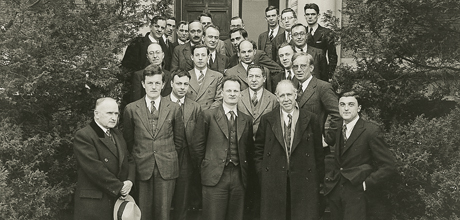Prominent physicists from all over the world gathered at GW conferences beginning in the 1930s.
By William C. Parke, Professor Emeritus of Physics
Note: This article is the second in an occasional series focusing on events, people and places that made history during some of the 10 decades since GW moved to Foggy Bottom in 1912.
When the already renowned physicist George Gamow was recruited to George Washington University in 1934, he agreed to come under a couple of conditions: He wanted to bring friend and colleague Edward Teller and he wanted the resources to organize yearly conferences on current topics in physics.
So from 1935 to 1947 (excluding the World War II years 1943-1945), Dr. Gamow and Dr. Teller were able to attract a few dozen of the most prominent physicists in the world to GW’s campus at a time when new physics was flourishing. During the Washington Conferences on Theoretical Physics, fruitful ideas surfaced in presentations and informal discussions focused on topics like nuclear reactions, stellar processes, low temperature physics and gravitation. These ideas aided in understanding nature and led to many far-reaching applications now part of modern technology.
At the 1938 conference on stellar energy, or the internal energy of stars, nuclear physicist Hans Bethe crystallized his ideas on what processes produce energy in stars like the sun. On his way back to work at Cornell University, he determined all the important nuclear reactions involved, and calculated the observed properties of the sun. He received the 1967 Nobel Prize for this work.

The most famous idea came from the announcement by Niels Bohr at the 1939 conference, in the Hall of Government, room 209, that the nucleus of uranium had been split by bombardment with neutrons, with significant energy released. This was the dawn of the atomic age.
Dr. Gamow loved to think about new ideas. He wrote about them in technical and in popular literature. One of the fields that interested him was cosmology: How did the universe and its elements come about? He made stellar evolution and cosmology the focus of the 1942 conference. After the war, he came back to this topic, developing his “hot big bang theory,” correctly predicting the ratio of helium to hydrogen in the universe. He also predicted that there should be relic radiation left over from the big bang.
Dr. Gamow also wanted to understand how living things worked. As such, the 1946 conference theme was “Physics of Living Matter.” The invitees were among the most prominent physicists and biophysicists in the world. Only a few years later in 1953, within a few months after James Watson and Francis Crick discovered the structure of DNA, Dr. Gamow was the first to ask how the DNA structure codes for proteins, and then suggest a solution.
The 1947 conference focused on the new field of quantum electrodynamics and developments in gravitation theory. Participating were Richard Feynman and Julian Schwinger, just at the time when they were independently developing methods for calculating the observable effects of quantum fluctuations in electromagnetic fields. For this insight, they, together with Sin-Itiro Tomonaga in Japan, were awarded the Nobel Prize in 1965.
Humanity has been affected by the technology that grew from the physics of the 1930s and 1940s. Being informal, limited in size and attracting the greatest physicists of the time, the Washington Conferences on Theoretical Physics at GW significantly influenced the present understanding of fundamental physical processes as well as the resulting practical applications that can make life easier—all while laying a wider foundation for future developments.
Three plaques commemorating Dr. Gamow, Dr. Teller and the Atomic Age can be found in the front of Corcoran Hall. Since 2002, GW has also offered the George Gamow Undergraduate Research Fellowship in honor of the famed physicist.


